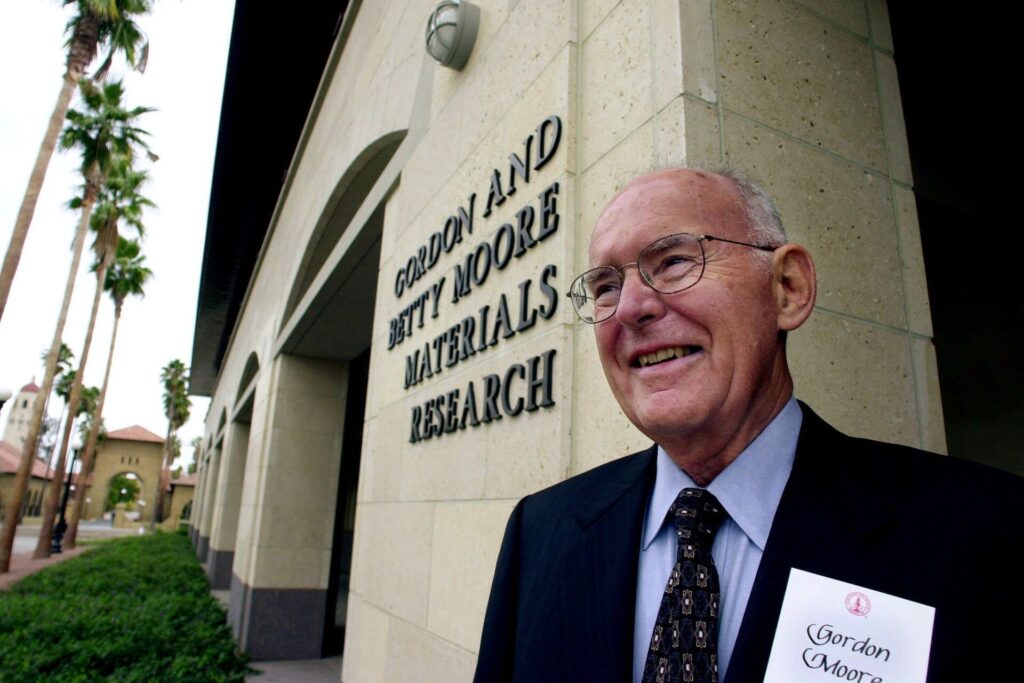Gordon Moore, co-founder of Intel and a pioneer in the semiconductor industry, passed away at the age of 94 in Hawaii, surrounded by family. Moore, along with Robert Noyce and Andy Grove, launched Intel in 1968, and their “Intel Inside” processors became a staple in over 80% of the world’s personal computers. In 1965, Moore wrote an article observing that the number of transistors on microchips had doubled every year since integrated circuits were invented. This prediction became known as “Moore’s Law” and drove Intel and other chipmakers to invest in research and development to ensure it remained true. Moore’s work led to the exponential growth of the computer industry, and he inspired other engineers with his talent and dedication. Moore was also an environmentalist and philanthropist, founding a foundation with his wife that focused on environmental causes and giving hundreds of millions to his alma mater, the California Institute of Technology.

- Moore observed that, thanks to improvements in technology, the number of transistors on microchips had roughly doubled every year since integrated circuits were invented a few years before.
- His prediction that the trend would continue became known as “Moore’s Law” and, later amended to every two years, it helped push Intel and rival chipmakers to aggressively target their research and development resources to make sure that rule of thumb came true.
- Chips became more efficient and less expensive at an exponential rate, helping drive much of the world’s technological progress for half a century and allowing the advent of not just personal computers, but the internet and Silicon Valley giants like Apple (AAPL), Facebook (FB) and Google (GOOG).
- Despite manufacturing stumbles that have caused Intel to lose market share in recent years, current CEO Pat Gelsinger has said he believes Moore’s Law still holds as the company invests billions of dollars in a turnaround effort.
- Moore earned a Ph.D. in chemistry and physics in 1954 at the California Institute of Technology.
- He went to work at the Shockley Semiconductor Laboratory where he met future Intel cofounder Robert Noyce.
- In 1968, Moore and Noyce left Fairchild to start the memory chip company soon to be named Intel, an abbreviation of Integrated Electronics.
- While Noyce had theories about how to solve chip engineering problems, Moore was the person who rolled up his sleeves and spent countless hours tweaking transistors and refining Noyce’s broad and sometimes ill-defined ideas, efforts that often paid off. Grove filled out the group as Intel’s operations and management expert.
- Moore received a Medal of Freedom, the nation’s highest civilian honor, from President George W. Bush in 2002.
- He and his wife had two children.

Moore earned a Ph.D. in chemistry and physics from the California Institute of Technology in 1954. He began his career at the Shockley Semiconductor Laboratory, where he met Noyce, and together they left to launch Fairchild Semiconductor in 1957. In 1968, they founded Intel, which became a leader in memory chip technology, microprocessors, and personal computers.
Moore served as executive president of Intel until 1975, and then as CEO and chairman from 1979 to 1997. Under his leadership, Intel made significant contributions to the growth of the computer industry and advancements in technology.

Moore’s philanthropic efforts were also extensive. His foundation focused on environmental causes such as protecting the Amazon River basin and salmon streams in Canada, Russia, and the United States. He donated millions to the California Institute of Technology to support technology and science research and development. He also supported the Search for Extraterrestrial Intelligence project known as SETI.
Moore received several awards and honors throughout his life, including the National Medal of Technology and Innovation, the Presidential Medal of Freedom, and the IEEE Medal of Honor. In 2023, Forbes magazine estimated his net worth at $7.2 billion.